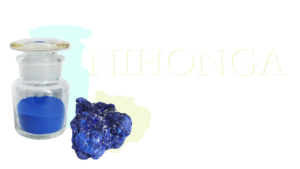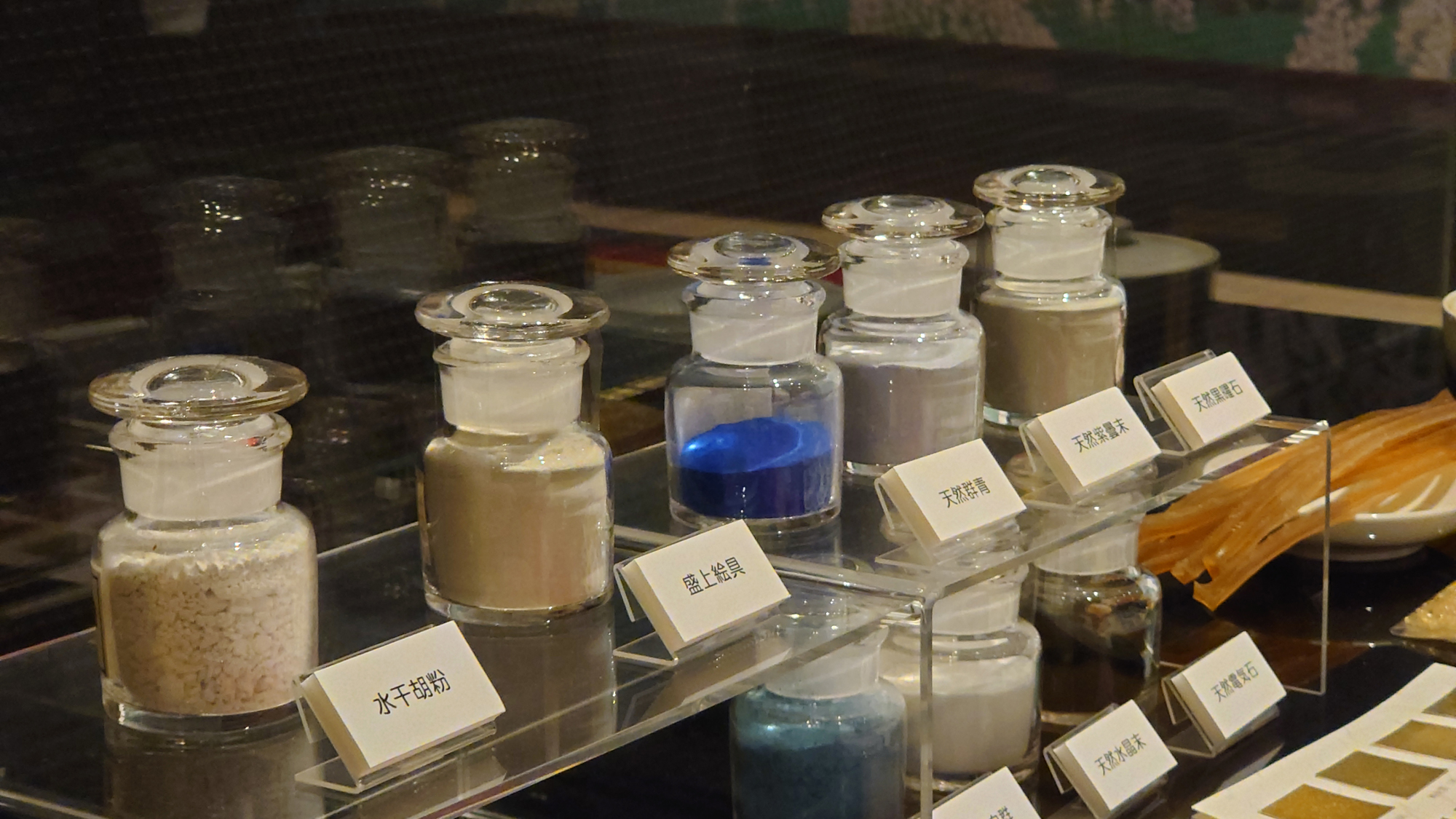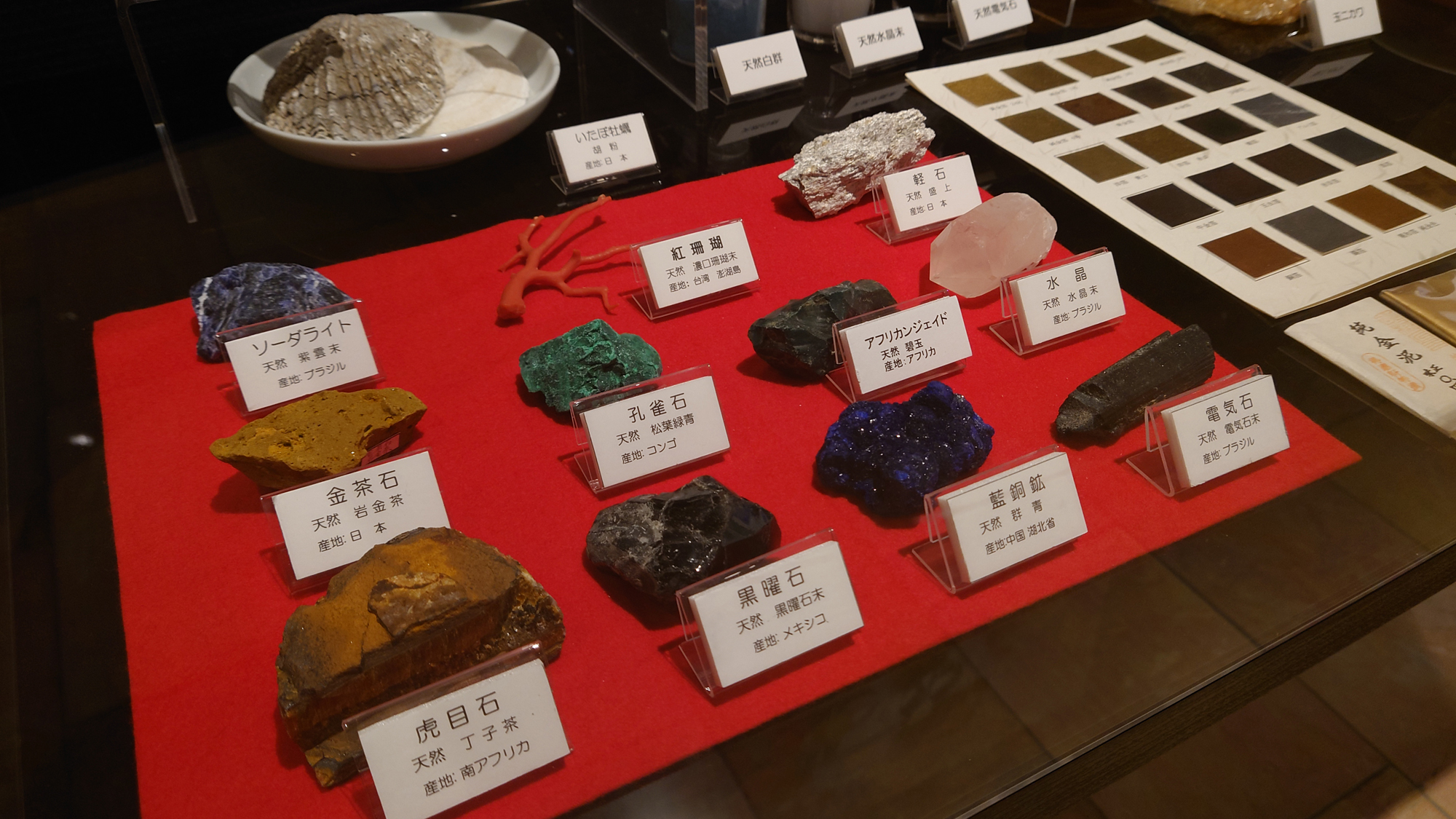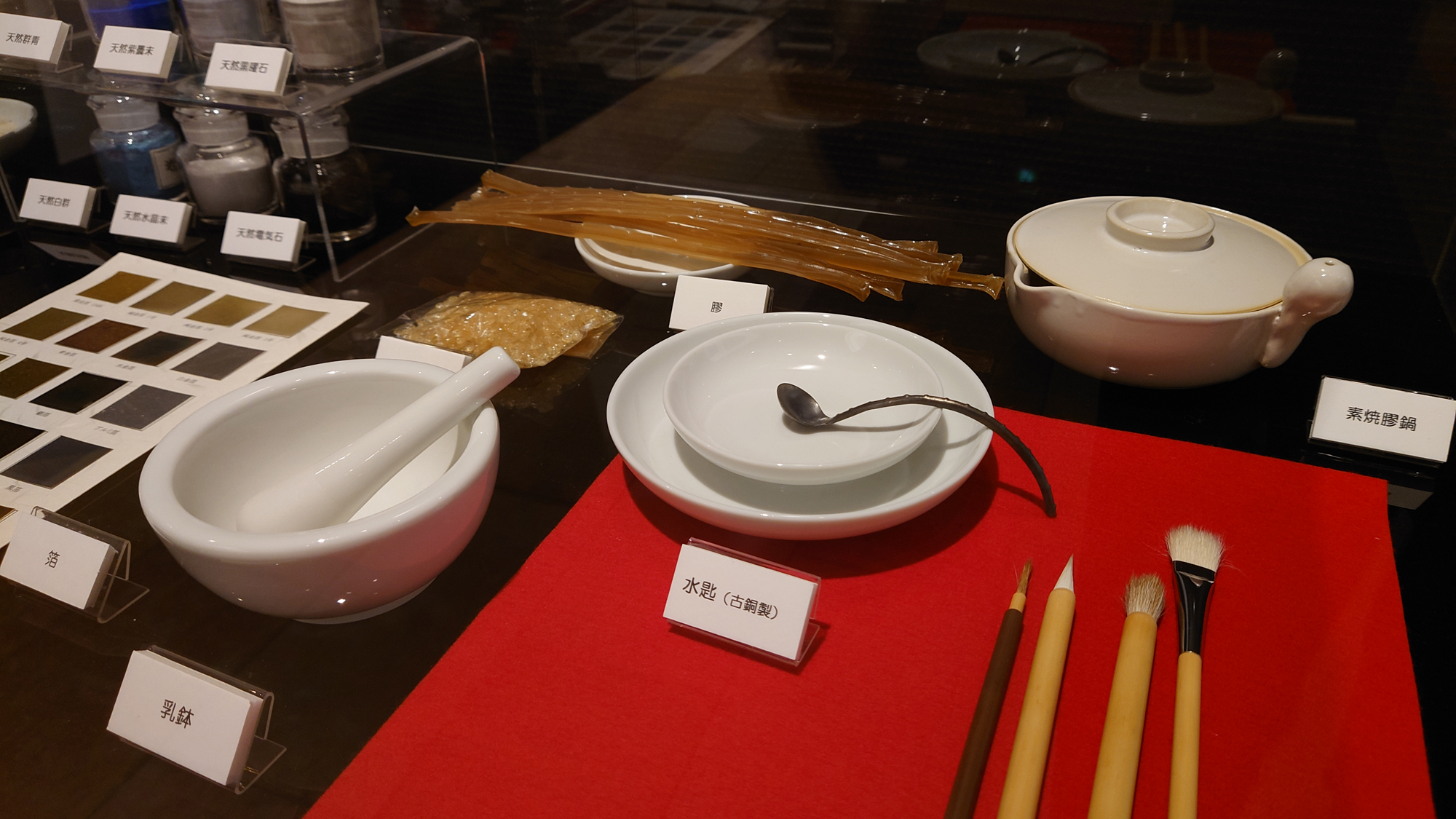日本画について | WHAT IS NIHONGA

日本画について
日本画は、明治以降(1868年~)に日本に入ってきた西洋画に対して作られた言葉・概念です。それ以前は日本画の概念はなく、様式として各流派(狩野派、円山・四条派、大和絵など)に別れていました。西洋画が入ってきた明治以降、各流派は折衷、混ざり合いながら西洋画の要素も取り入れて、日本画は発展してきました。
現在の日本画は、伝統的な日本の絵画を総称する意味と、伝統的な日本の絵画技法を継承しつつも西洋画法を取り入れた新しい絵画を総称する意味があります。
日本画という特定の絵画様式はありませんが、使用される基底材には板、麻、絹、紙などがあり、使用される絵の具に、岩絵の具等の天然の顔料を膠で接着させて描く絵画として、広く知られています。
日本画は、明治以降(1868年~)に日本に入ってきた西洋画に対して作られた言葉・概念です。それ以前は日本画の概念はなく、様式として各流派(狩野派、円山・四条派、大和絵など)に別れていました。西洋画が入ってきた明治以降、各流派は折衷、混ざり合いながら西洋画の要素も取り入れて、日本画は発展してきました。
現在の日本画は、伝統的な日本の絵画を総称する意味と、伝統的な日本の絵画技法を継承しつつも西洋画法を取り入れた新しい絵画を総称する意味があります。
日本画という特定の絵画様式はありませんが、使用される基底材には板、麻、絹、紙などがあり、使用される絵の具に、岩絵の具等の天然の顔料を膠で接着させて描く絵画として、広く知られています。
What is Nihonga
Japanese Painting – Traditional and Contemporary
Nihonga – literally meaning Japanese painting – is a term and concept that was created in response to the widespread influence of Western painting (or “seiyoga”), which first made its way to Japan during the Meiji era (beginning 1868). Prior to that, the styles of Japanese painting were divided into disparate indigenous schools/ styles of art – the Kano-ha, the Maruyama Shijo-ha, and perhaps most influential to Nihonga -Yamato-e and Tosa-ha.
After the arrival of Western painting to Japan during the Meiji era, the techniques of the various indigenous schools were blended and fused together along with various elements of Western painting, including perspective techniques, shading, and motif variety – creating what we now know today as Nihonga. In this way, the history of Nihonga- and Japanese art as a whole – is one of continuous incorporation, evolution, and refinement.
Today, the word “Nihonga” (日本画) – literally meaning Japanese painting – can be used to identify both traditional Japanese painting, and new styles of work that incorporate Western painting methods while carrying on the classical techniques of Japanese art forms. Although Nihonga does not refer to any single defined style, the unifying elements generally include the practice of painting on substrates such as wood, hemp, silk, and paper, and painting with coloring materials such as mineral pigments and other natural colorants that are bound with organic gelatin known as nikawa-eki.
Japanese Painting – Traditional and Contemporary
Nihonga – literally meaning Japanese painting – is a term and concept that was created in response to the widespread influence of Western painting (or “seiyoga”), which first made its way to Japan during the Meiji era (beginning 1868). Prior to that, the styles of Japanese painting were divided into disparate indigenous schools/ styles of art – the Kano-ha, the Maruyama Shijo-ha, and perhaps most influential to Nihonga -Yamato-e and Tosa-ha.
After the arrival of Western painting to Japan during the Meiji era, the techniques of the various indigenous schools were blended and fused together along with various elements of Western painting, including perspective techniques, shading, and motif variety – creating what we now know today as Nihonga. In this way, the history of Nihonga- and Japanese art as a whole – is one of continuous incorporation, evolution, and refinement.
Today, the word “Nihonga” (日本画) – literally meaning Japanese painting – can be used to identify both traditional Japanese painting, and new styles of work that incorporate Western painting methods while carrying on the classical techniques of Japanese art forms. Although Nihonga does not refer to any single defined style, the unifying elements generally include the practice of painting on substrates such as wood, hemp, silk, and paper, and painting with coloring materials such as mineral pigments and other natural colorants that are bound with organic gelatin known as nikawa-eki.



日本画の画材について | Mineral Pigments used in Nihonga
岩絵具:
岩絵具には、天然岩絵具や、人工的につくられる新岩絵具、合成岩絵具などがあります。
天然岩絵具の中で代表的な岩絵の具は、藍銅鉱(らんどうこう)から取れる「群青(ぐんじょう)」、孔雀石(くじゃくいし)から取れる「緑青(ろくしょう)」があります。古くは、西洋でも使用されていました。
チューブから出して使える絵の具とは異なり、膠液と混ぜて使用します。
粒子の粗い顔料を膠の接着力で画面に固定します。そのため、粒子の色味がそのまま絵肌に表れます。
天然岩絵具は、焼いて色味を変化させることもできます。
水干(すいひ)絵具:
粉状の絵具で、天然の土から作られる「黄土」や、牡蠣や蛤から精製して作られる「胡粉」があります。胡粉は、乳鉢と乳棒を使用して、だまが無くなるまで、すり潰してから使用します。画面の盛り上げ材としての使用もできます。
膠(にかわ):
牛などの動物の皮や腱からとれるゼラチンで、接着剤として使用します。
基底材:
日本画では、雲肌麻紙、楮紙(こうぞし)、雁皮紙(がんぴし)、絹、木板などが基底材に使用されます。
雲肌麻紙は、楮と麻を原料に作られた手漉き和紙で、明治時代以降に日本画の為に進化をとげた強靱な紙です。
Mineral Pigments used in Nihonga:
The illustrious colours that are one of the hallmarks of Nihonga paintings come from the entirely unique iwa-enogu, or mineral pigments, used by Nihonga artists. Traditionally artists used tennen iwa-enogu, or natural pigments, which were limited to the colours of the various rocks and minerals as they were found in the natural world. Although today artists continue to use natural pigments, two synthetic types called shin iwa-enogu, and gosei iwa-enogu have also become increasingly popular as they have broadened the colour palate available to Nihonga artists.
Among the most expensive and exemplary types of natural pigments are gunjo (deep blue colour) made from randoko (copper ore), and rokusho (verdigris green) made from (kujakuishi) malachite – both of which have also been traditionally used in western-style art as well.
Unlike other types of paint, iwa-enogu is not extracted from a tube, instead, the mineral powder is mixed with an animal glue called nikawa-eki, and mixed by hand. The nikawa gives the mineral powder adhesive properties and thus allow the artist to apply it to the painting surface. It is the coarse mineral grains that remain on the surface of the painting that can often give Nihonga its characteristic shimmer. Natural mineral pigments can also be further enhanced by the artist applying a small amount of heat to bring out deeper hues.
Suihi-enogu (soil based iwa-enogu):
Gofun, a type of suihi-enogu, is a white powder made with a combination of naturally occurring yellow ochre (silica and clay), and purified clam and oyster shells. The coarse white powder is further refined in a mortar and pestle before being mixed with water and applied to the painting surface. Gofun is primarily used as a base primer-like paint in order to enhance the vibrancy of other colours.
Nikawa:
An animal based gelatin derived from boiling cowhide and other animal tendons. This is melted down with warm water to form an adhesive glue-like substance.
Painting Surfaces:
Nihonga is composed on a variety of traditional hand-made papers including kumohadamashi, kozoshi mulberry-fiber paper, ganpishi paper, silk, and wood paneling. Kumohadamashi paper is comprised of mulberry and hemp and was created in the Meiji period specifically as a more durable paper type for composing Nihonga. The heavy-duty nature of mulberry and hemp fibers are able to endure the generous application of water, nikawa-eki, and mineral pigments that are layered many times throughout the painting process – without ever warping or breaking apart.
The illustrious colours that are one of the hallmarks of Nihonga paintings come from the entirely unique iwa-enogu, or mineral pigments, used by Nihonga artists. Traditionally artists used tennen iwa-enogu, or natural pigments, which were limited to the colours of the various rocks and minerals as they were found in the natural world. Although today artists continue to use natural pigments, two synthetic types called shin iwa-enogu, and gosei iwa-enogu have also become increasingly popular as they have broadened the colour palate available to Nihonga artists.
Among the most expensive and exemplary types of natural pigments are gunjo (deep blue colour) made from randoko (copper ore), and rokusho (verdigris green) made from (kujakuishi) malachite – both of which have also been traditionally used in western-style art as well.
Unlike other types of paint, iwa-enogu is not extracted from a tube, instead, the mineral powder is mixed with an animal glue called nikawa-eki, and mixed by hand. The nikawa gives the mineral powder adhesive properties and thus allow the artist to apply it to the painting surface. It is the coarse mineral grains that remain on the surface of the painting that can often give Nihonga its characteristic shimmer. Natural mineral pigments can also be further enhanced by the artist applying a small amount of heat to bring out deeper hues.
Suihi-enogu (soil based iwa-enogu):
Gofun, a type of suihi-enogu, is a white powder made with a combination of naturally occurring yellow ochre (silica and clay), and purified clam and oyster shells. The coarse white powder is further refined in a mortar and pestle before being mixed with water and applied to the painting surface. Gofun is primarily used as a base primer-like paint in order to enhance the vibrancy of other colours.
Nikawa:
An animal based gelatin derived from boiling cowhide and other animal tendons. This is melted down with warm water to form an adhesive glue-like substance.
Painting Surfaces:
Nihonga is composed on a variety of traditional hand-made papers including kumohadamashi, kozoshi mulberry-fiber paper, ganpishi paper, silk, and wood paneling. Kumohadamashi paper is comprised of mulberry and hemp and was created in the Meiji period specifically as a more durable paper type for composing Nihonga. The heavy-duty nature of mulberry and hemp fibers are able to endure the generous application of water, nikawa-eki, and mineral pigments that are layered many times throughout the painting process – without ever warping or breaking apart.
日本画の道具について | Tools of the trade
日本画の筆:
日本画の筆は、数種の混毛で作られています。 もともとは、書画と日本画の筆は区別が無かったのですが、 日本に西洋画(油彩画、西洋表現)が流れてきてからは、日本画の描き方も幅が広がり、日本画専用の筆が作られるようになりました。
・狼狸面相筆(ろうりめんそう):イタチと狸の毛を混ぜて作られたもの。面相筆は、細い線を引く時に使用します。
・削用筆(さくようふで):羊毛にイタチの毛を混ぜて作られたもの。太細のある硬い線を引く時に使用します。
・即妙筆(そくみょうふで):彩色筆の1つ。羊毛に猫毛を混ぜて作られたもの。柔らかくたっぷりした線を描くのに使用します。
・彩色筆(さいしきふで):絵の具の水分をたっぷり含ませるために、羊毛で作られています。
・隈取筆(くまどりふで):絵の具や墨をぼかしたり、輪郭を隈取るのに使用します。
・平筆(ひらふで):羊毛を平らに並べた平らな筆。面での彩色をする時に使用します。
日本画の筆は、数種の混毛で作られています。 もともとは、書画と日本画の筆は区別が無かったのですが、 日本に西洋画(油彩画、西洋表現)が流れてきてからは、日本画の描き方も幅が広がり、日本画専用の筆が作られるようになりました。
・狼狸面相筆(ろうりめんそう):イタチと狸の毛を混ぜて作られたもの。面相筆は、細い線を引く時に使用します。
・削用筆(さくようふで):羊毛にイタチの毛を混ぜて作られたもの。太細のある硬い線を引く時に使用します。
・即妙筆(そくみょうふで):彩色筆の1つ。羊毛に猫毛を混ぜて作られたもの。柔らかくたっぷりした線を描くのに使用します。
・彩色筆(さいしきふで):絵の具の水分をたっぷり含ませるために、羊毛で作られています。
・隈取筆(くまどりふで):絵の具や墨をぼかしたり、輪郭を隈取るのに使用します。
・平筆(ひらふで):羊毛を平らに並べた平らな筆。面での彩色をする時に使用します。
Brushes used for Nihonga:
The brushes used for painting Nihonga are made from a variety of different animal hairs. Historically brushes used for the various art forms of Japan did not differ greatly. However, the years following the introduction of western-style oil painting to Japan left the traditionally opaque colours and lines of Nihonga looking weak by comparison. Soon, styles of drawing Nihonga greatly diversified, which gradually lead to the birth of a dedicated brush types that could imprint bolder lines and colours.
・Rorimensofude (fine point brush) – Combination of hair from itachi (Japanese weasel) and tanuki (Japanese racoon-like animal). This fine-point brush is used for drawing the thinner lines of a Nihonga work.
・Sakuyofude (mid-sized, dynamic use brush) – Combination of sheep and itachi (Japanese weasel) hairs. This dynamic brush type allows the artist to draw lines that begin boldly and end with a fine whisp-like flourish.
・Sokumyoufude (brush used for colouring) – Combination of sheep and cat hairs. This brush creates soft yet ample lines.
・Saishikifude (painting brush) – Made exclusively of dense wool fibers. This dense wool brush is able to hold a generous amount of liquid mineral pigment mixture which makes it ideal for painting larger portions of the work.
・Kumadorifude (shading brush) – This brush is used primarily to create gradation and shading effects with both sumi-ink and liquid mineral pigments.
・Hirafude (broad brush) – A thick, broad brush made of exclusively wool fibers. Used to cover large areas in colour with ease.
The brushes used for painting Nihonga are made from a variety of different animal hairs. Historically brushes used for the various art forms of Japan did not differ greatly. However, the years following the introduction of western-style oil painting to Japan left the traditionally opaque colours and lines of Nihonga looking weak by comparison. Soon, styles of drawing Nihonga greatly diversified, which gradually lead to the birth of a dedicated brush types that could imprint bolder lines and colours.
・Rorimensofude (fine point brush) – Combination of hair from itachi (Japanese weasel) and tanuki (Japanese racoon-like animal). This fine-point brush is used for drawing the thinner lines of a Nihonga work.
・Sakuyofude (mid-sized, dynamic use brush) – Combination of sheep and itachi (Japanese weasel) hairs. This dynamic brush type allows the artist to draw lines that begin boldly and end with a fine whisp-like flourish.
・Sokumyoufude (brush used for colouring) – Combination of sheep and cat hairs. This brush creates soft yet ample lines.
・Saishikifude (painting brush) – Made exclusively of dense wool fibers. This dense wool brush is able to hold a generous amount of liquid mineral pigment mixture which makes it ideal for painting larger portions of the work.
・Kumadorifude (shading brush) – This brush is used primarily to create gradation and shading effects with both sumi-ink and liquid mineral pigments.
・Hirafude (broad brush) – A thick, broad brush made of exclusively wool fibers. Used to cover large areas in colour with ease.
日本画の描き方 | Drawing NIHONGA
~雲肌麻紙に描く~
①モチーフ探しとスケッチ
花、植物、動物、人物、風景など、描きたいモチーフを探します。
モチーフが決まったら、スケッチを繰り返す。
写生ではなく、写意。
モノの形を捉え、モノから受ける印象を描き留めます。
日本画では、モチーフを正確に描写するだけでなく、 モチーフの本質を捉え描きます。
②構図を考える
スケッチを材料に、余白などバランスを考えながら本画の構図を考えます。
③下図を作成
本画を作成する前に、小さい画面の小下図(しょうしたず)を描きます。
小下図では、作品全体の完成イメージを構想します。
小下図で構図が決まったら、本画の原寸大の大きさで大下図を描きます。
大下図では、スケッチで得たモチーフの本質を表現する為に、 細かい線などを見直していき、完成イメージをより明確にしていきます。
④画面の準備
雲肌麻紙に、にじみ止め為の礬水(どうさ)を引きます。
礬水は、明礬(みょうばん)を膠液(にかわえき)で溶いたもの。
表裏2回程度(1回につき、1日乾燥させます)
※膠液は、時間をかけて、ぬるま湯に膠を溶かして作ります。
礬水を引いた雲肌麻紙に、耐久性を更に持たせる為、裏打ちの紙を張ります。
本紙に影響がないように、木製パネルにアク止め処理の為の和紙を貼りつけます。
裏打ちした紙を、和紙を貼りつけた状態の木製のパネルに水張りします。
⑤本画へ転写
準備を終えた雲肌麻紙に大下図を転写(トレース)します。
転写は念紙(カーボン紙のようなもの)を使用します。
⑥骨描き(こつがき)
色を重ねても線が消えないように、トレースした線を墨でなぞります。
そのあと、しっかり乾燥をさせます。
⑦下地作り
発色をよくする為に、胡粉(白)など淡い色で、何回も画面全体を重ね塗りします。
この作業で、上から塗る絵の具がしっかり定着するようにもなります。
胡粉は、牡蠣(かき)や蛤(はまぐり)から精製された白い粉です。
そのままでは画面に定着しないので、膠液と混ぜて使用します。
⑧絵の具の準備
「絵の具を溶く」
日本画で使用される岩絵の具、胡粉は、そのままでは画面に定着しないので、 膠液と混ぜて使用します。
特に、胡粉と膠液を混ぜるには、手間と時間がかかります。
作家は、絵の具を作る時間の中で、イメージを膨らませたり、構図を再考したりします。
⑨画面に彩色する
日本画の絵の具は乾くのが遅い為、画面は平置きして彩色します。
岩絵の具は、粒子の粗いものから細かいものまで、種類が豊富ですが、 塗り重ねをする部分は、粒子の細かいもの(被覆力があるもの)から塗り重ねて、次第に粗いものを塗っていきます。
画面のひび割れを防ぐために、膠の濃度は下地に近いほど濃くし、塗り重ねるにしたがって、薄くしていきます。
⑩完成
完成イメージに到達したら、印を押して、サインを書いて完成です。
①モチーフ探しとスケッチ
花、植物、動物、人物、風景など、描きたいモチーフを探します。
モチーフが決まったら、スケッチを繰り返す。
写生ではなく、写意。
モノの形を捉え、モノから受ける印象を描き留めます。
日本画では、モチーフを正確に描写するだけでなく、 モチーフの本質を捉え描きます。
②構図を考える
スケッチを材料に、余白などバランスを考えながら本画の構図を考えます。
③下図を作成
本画を作成する前に、小さい画面の小下図(しょうしたず)を描きます。
小下図では、作品全体の完成イメージを構想します。
小下図で構図が決まったら、本画の原寸大の大きさで大下図を描きます。
大下図では、スケッチで得たモチーフの本質を表現する為に、 細かい線などを見直していき、完成イメージをより明確にしていきます。
④画面の準備
雲肌麻紙に、にじみ止め為の礬水(どうさ)を引きます。
礬水は、明礬(みょうばん)を膠液(にかわえき)で溶いたもの。
表裏2回程度(1回につき、1日乾燥させます)
※膠液は、時間をかけて、ぬるま湯に膠を溶かして作ります。
礬水を引いた雲肌麻紙に、耐久性を更に持たせる為、裏打ちの紙を張ります。
本紙に影響がないように、木製パネルにアク止め処理の為の和紙を貼りつけます。
裏打ちした紙を、和紙を貼りつけた状態の木製のパネルに水張りします。
⑤本画へ転写
準備を終えた雲肌麻紙に大下図を転写(トレース)します。
転写は念紙(カーボン紙のようなもの)を使用します。
⑥骨描き(こつがき)
色を重ねても線が消えないように、トレースした線を墨でなぞります。
そのあと、しっかり乾燥をさせます。
⑦下地作り
発色をよくする為に、胡粉(白)など淡い色で、何回も画面全体を重ね塗りします。
この作業で、上から塗る絵の具がしっかり定着するようにもなります。
胡粉は、牡蠣(かき)や蛤(はまぐり)から精製された白い粉です。
そのままでは画面に定着しないので、膠液と混ぜて使用します。
⑧絵の具の準備
「絵の具を溶く」
日本画で使用される岩絵の具、胡粉は、そのままでは画面に定着しないので、 膠液と混ぜて使用します。
特に、胡粉と膠液を混ぜるには、手間と時間がかかります。
作家は、絵の具を作る時間の中で、イメージを膨らませたり、構図を再考したりします。
⑨画面に彩色する
日本画の絵の具は乾くのが遅い為、画面は平置きして彩色します。
岩絵の具は、粒子の粗いものから細かいものまで、種類が豊富ですが、 塗り重ねをする部分は、粒子の細かいもの(被覆力があるもの)から塗り重ねて、次第に粗いものを塗っていきます。
画面のひび割れを防ぐために、膠の濃度は下地に近いほど濃くし、塗り重ねるにしたがって、薄くしていきます。
⑩完成
完成イメージに到達したら、印を押して、サインを書いて完成です。
Using kumohadamashi (Handmade Japanese paper)
1 Motif selection and initial sketch
The artist begins by selecting from a variety of motifs such as flowers, plants, people, landscapes, and others. They then begin their initial sketch which is meant only to be detailed enough to capture the faintest outlines of their subject. The unique beauty of Nihonga technique is found not only in the artist’s ability to draw the form of the subject faithfully, but perhaps more importantly, it is found in the ability to capture the essence of the motif as it is found in the natural world.
2 Composition
With the initial sketch complete, the artist now decides upon the composition for their work, paying particular attention to the weight of both unpainted and painted space.
3 Drawing the shoushitazu ‘lower illustration’ (practice)
Before the artist begins the formal piece, they first compose the shoushitazu, or ‘small-lower illustration,’ onto a small practice surface in order to understand what the final work will look like. After making any necessary changes to the composition or line work, the artist then draws what is known as the ooshitazu, or ‘ large lower illustration,’ which is of similar or identical size to the formal work. At this phase, more detailed lines and even sometimes colours are added to the sketch as the artist gets closer to understanding what the final piece will look like.
4 Preparing the drawing surface
In order to prevent colours from running when painting begins, the artist coats the kumohadamashi paper with a special solution called dosa. This solution is made by mixing an animal glue called nikawa, warm water, and a white powder called myoban ( known as alum or potassium alum.) Each side of the paper is coated twice, with each side taking as much as 24 hours to dry before the artist is able to apply the second layer.
Once the paper is dried and sufficiently coated with the dosa mixture, the artist further bolsters the durability of the paper by mounting the kumohadamashi paper onto a wooden panel which itself has a layer of washi paper over it in order to make the painting surface as smooth as possible.
5 Transcribing the motif
Now that preparation is completed, the artist uses carbon paper to transcribe their drawing from the oshitazu onto the mounted kumohadamashi paper.
6 Drawing the Kotsugaki (the ‘bones’ or outline)
The artist now finalizes the form of the piece by tracing over the faint lines made by the carbon paper with a fude (brush) and black ink before allowing it to dry. The inked lines will now remain clearly visible throughout the painting process.
7 Shitaji-zukuri (Underpainting)
In an effort highlight certain colours, or convey a certain tone within their motif, the artist can coat the entire paper’s surface with an underlayer of a single opaque colour. Often, a white solution called gofun is used during this process which really makes the brighter colours of the painting appear especially vibrant. Gofun is most frequently made from the ground up shells of clams and oysters.
8 Preparing the materials- Dissolving the mineral pigments
Because the mineral powders used in Nihonga, known as ‘iwa-enogu,’ do not themselves have any adhesive properties, they must first be mixed by hand into a liquid solution of nikawa-eki (mixture of animal gelatin and warm water formed into a glue like substance). The process of mixing each mineral pigment by hand into the solution of nikawa-eki is time consuming and labour intensive. However, the artist can use this time to reflect once more upon the composition, essence, and other aspects of their painting.
9 Applying colours
Because the mineral pigments take a significantly long time to dry, Nihonga is painted with the panel lying flat in front of the artist instead of upright as in other art forms.
The mineral pigments also differ not only in colour, but in the size of the individual grains of powder. The artist will layer the individual mineral pigments from smallest grain size to largest. This technique not only contributes to Nihonga’s signature appearance of depth and texture, but also prevents the powdered mineral pigments from falling off the paper’s surface after the work has dried. Ensuring the nikawa is applied in generous and thick coats further prevents flaking and cracking.
10 Completion
The artist applies their seal and or signature, and the composition is now complete.
1 Motif selection and initial sketch
The artist begins by selecting from a variety of motifs such as flowers, plants, people, landscapes, and others. They then begin their initial sketch which is meant only to be detailed enough to capture the faintest outlines of their subject. The unique beauty of Nihonga technique is found not only in the artist’s ability to draw the form of the subject faithfully, but perhaps more importantly, it is found in the ability to capture the essence of the motif as it is found in the natural world.
2 Composition
With the initial sketch complete, the artist now decides upon the composition for their work, paying particular attention to the weight of both unpainted and painted space.
3 Drawing the shoushitazu ‘lower illustration’ (practice)
Before the artist begins the formal piece, they first compose the shoushitazu, or ‘small-lower illustration,’ onto a small practice surface in order to understand what the final work will look like. After making any necessary changes to the composition or line work, the artist then draws what is known as the ooshitazu, or ‘ large lower illustration,’ which is of similar or identical size to the formal work. At this phase, more detailed lines and even sometimes colours are added to the sketch as the artist gets closer to understanding what the final piece will look like.
4 Preparing the drawing surface
In order to prevent colours from running when painting begins, the artist coats the kumohadamashi paper with a special solution called dosa. This solution is made by mixing an animal glue called nikawa, warm water, and a white powder called myoban ( known as alum or potassium alum.) Each side of the paper is coated twice, with each side taking as much as 24 hours to dry before the artist is able to apply the second layer.
Once the paper is dried and sufficiently coated with the dosa mixture, the artist further bolsters the durability of the paper by mounting the kumohadamashi paper onto a wooden panel which itself has a layer of washi paper over it in order to make the painting surface as smooth as possible.
5 Transcribing the motif
Now that preparation is completed, the artist uses carbon paper to transcribe their drawing from the oshitazu onto the mounted kumohadamashi paper.
6 Drawing the Kotsugaki (the ‘bones’ or outline)
The artist now finalizes the form of the piece by tracing over the faint lines made by the carbon paper with a fude (brush) and black ink before allowing it to dry. The inked lines will now remain clearly visible throughout the painting process.
7 Shitaji-zukuri (Underpainting)
In an effort highlight certain colours, or convey a certain tone within their motif, the artist can coat the entire paper’s surface with an underlayer of a single opaque colour. Often, a white solution called gofun is used during this process which really makes the brighter colours of the painting appear especially vibrant. Gofun is most frequently made from the ground up shells of clams and oysters.
8 Preparing the materials- Dissolving the mineral pigments
Because the mineral powders used in Nihonga, known as ‘iwa-enogu,’ do not themselves have any adhesive properties, they must first be mixed by hand into a liquid solution of nikawa-eki (mixture of animal gelatin and warm water formed into a glue like substance). The process of mixing each mineral pigment by hand into the solution of nikawa-eki is time consuming and labour intensive. However, the artist can use this time to reflect once more upon the composition, essence, and other aspects of their painting.
9 Applying colours
Because the mineral pigments take a significantly long time to dry, Nihonga is painted with the panel lying flat in front of the artist instead of upright as in other art forms.
The mineral pigments also differ not only in colour, but in the size of the individual grains of powder. The artist will layer the individual mineral pigments from smallest grain size to largest. This technique not only contributes to Nihonga’s signature appearance of depth and texture, but also prevents the powdered mineral pigments from falling off the paper’s surface after the work has dried. Ensuring the nikawa is applied in generous and thick coats further prevents flaking and cracking.
10 Completion
The artist applies their seal and or signature, and the composition is now complete.
参考書籍
『図解 日本画用語事典』
編集:東京藝術大学大学院文化財保存学日本画研究室
発行:(株)東京美術
2007年5月30日 初版第1刷発行
『図解 日本画用語事典』
編集:東京藝術大学大学院文化財保存学日本画研究室
発行:(株)東京美術
2007年5月30日 初版第1刷発行

